Key Parameters and Optimal Design of a Split Induction Coil for T-Shaped Pipe Brazing
Abstract
1. Introduction
2. Multi-Physical Simulation of Induction Brazing
2.1. The Principle of the Induction Brazing
2.2. Finite Element Model
2.3. Experimental Design and Model Modification
3. Coil Parameters Design
- Larger-the-better (for example, production output);
- Smaller-the-better (for example, carbon emissions);
- On-target, minimum-variation (for example, a mating part in an assembly).
- (a)
- The magnetic intensity around the joint is stronger, and the score is higher.
- (b)
- The distribution of the magnetic field on both the round tube and the flat tube is more uniform, and the score is higher.
- (c)
- The temperature value on the flat tube is lower, and the score is higher.
- (d)
- The temperature field is more important than the magnetic field. Therefore, the magnetic field is defined as 40 percent of the full mark, and the temperature field is defined as 60 percent of the full mark.
4. Simulation and Experimental Results
4.1. Magnetic Field
4.2. Temperature Field and Deformation
5. Conclusions
- (1)
- A multi-physical simulation model with high precision was established. The melting of filler metal was almost consistent with the spatial distribution of the temperature field, and the temperature history in the header pipe could be consistent with the experimental results under different brazing parameters. The average simulation error was approximately 5.753 °C.
- (2)
- The Taguchi method was combined with multi-physical simulation to solve the multi-factor optimization problem. The optimal coil parameters were obtained with a turn number of 3.5, a turn space of 7 mm, a heating distance of 15.6 mm, a coil diameter of 8 mm, and a coil length of 9 mm. Three well-formed T-shaped joints could be obtained at one time via the optimal split coil.
- (3)
- The mechanism of a good joint form was clarified. The reason for the good joints lay in the significant decrease in the heating rate at high temperatures, which promoted the homogenization of the temperature and the melting and filling of the filler metal as well as avoided local overheating.
- (4)
- The relationship between the coil and the temperature field was clarified. The skin effects and the proximity effects induced a high magnetic field intensity around the joint, which had a significant relationship with the length of the coil and the diameter of the coil. The high magnetic field intensity promoted a high eddy current density in this place. As a result, the high Joule heat could be generated around the joint.
Author Contributions
Funding
Institutional Review Board Statement
Informed Consent Statement
Data Availability Statement
Conflicts of Interest
References
- Irabatti, V.; Patil, Y.; Kore, S.; Barangule, V.; Kothe, A. Comprehensive review of spiral heat exchanger for diverse applications. Mater. Today Proc. 2023, 72, 1328–1334. [Google Scholar] [CrossRef]
- Li, N.; Klemeš, J.J.; Sunden, B.; Wu, Z.; Wang, Q.; Zeng, M. Heat exchanger network synthesis considering detailed thermal-hydraulic performance: Methods and perspectives. Renew. Sustain. Energy Rev. 2022, 168, 112810. [Google Scholar] [CrossRef]
- Dai, W.; Xue, S.-B.; Lou, J.-Y.; Lou, Y.-B.; Wang, S.-Q. Torch brazing 3003 aluminum alloy with Zn—Al filler metal. Trans. Nonferrous Met. Soc. China 2012, 22, 30–35. [Google Scholar] [CrossRef]
- Yu, W.-Y.; Zhang, T.-Y.; Wang, Y.; Gao, M.-Z.; Shang, J.-X.; Yan, Z.-H.; Wu, W.-J.; Lin, Q.-L. Formation and elimination of burst phenomenon in ultrasonic-assisted resistance brazing. Trans. Nonferrous Met. Soc. China 2019, 29, 485–494. [Google Scholar] [CrossRef]
- Zhang, X.; Li, D.; Wang, L.; Wan, C.; Song, L.; Song, K.; Xiao, Y. Ultrasonic brazing of Zr-based bulk metallic glass and 1060 Al alloy using Zn-3Al filler metal. J. Adv. Join. Process. 2022, 5, 100095. [Google Scholar] [CrossRef]
- Nian, S.C.; Tsai, S.W.; Huang, M.S.; Huang, R.C.; Chen, C.H. Key parameters and optimal design of a single-layered induction coil for external rapid mold surface heating. Int. Commun. Heat Mass Transf. 2014, 57, 109–117. [Google Scholar] [CrossRef]
- Zhang, L. Filler metals, brazing processing and reliability for diamond tools brazing: A review. J. Manuf. Process. 2021, 66, 651–668. [Google Scholar] [CrossRef]
- Prasad, A.K.; Kapil, S.; Bag, S. Critical conditions for melting of metallic wire in induction heating system through numerical simulation and experiments. J. Manuf. Process. 2022, 77, 678–693. [Google Scholar] [CrossRef]
- Patil, M.; Choubey, R.K.; Jain, P.K. Influence of coil shapes on temperature distribution in induction heating process. Mater. Today Proc. 2023, 72, 3029–3035. [Google Scholar] [CrossRef]
- Heidari, H.; Tavakoli, M.H.; Shokri, A.; Moradi, B.M.; Sharifi, O.M.; Asaad, M.J.M. 3D simulation of the coil geometry effect on the induction heating process in Czochralski crystal growth system. Cryst. Res. Technol. 2020, 55, 1900147. [Google Scholar] [CrossRef]
- Mishra, A.; Bag, S.; Pal, S. Induction Heating in Sustainable Manufacturing and Material Processing Technologies-A State of the Art Literature Review. In Reference Module in Materials Science and Materials Engineering; Elsevier: Amsterdam, The Netherlands, 2020; Volume 1, pp. 343–357. [Google Scholar]
- Sung, Y.-T.; Hwang, S.-J.; Lee, H.-H.; Huang, D.-Y. Study on Induction Heating Coil for Uniform Mold Cavity Surface Heating. Adv. Mech. Eng. 2014, 6, 349078. [Google Scholar] [CrossRef]
- Nian, S.; Huang, M.; Tsai, T. Enhancement of induction heating efficiency on injection mold surface using a novel magnetic shielding method. Int. Commun. Heat Mass Transf. 2014, 50, 52–60. [Google Scholar] [CrossRef]
- Kim, M.; Youn, B.; Bullard, C.W. Effect of inclination on the air-side performance of a brazed aluminum heat exchanger under dry and wet conditions. Int. J. Heat Mass Transf. 2001, 44, 4613–4623. [Google Scholar] [CrossRef]
- Wen, H.; Han, Y. Study on mobile induction heating process of internal gear rings for wind power generation. Appl. Therm. Eng. 2017, 112, 507–515. [Google Scholar] [CrossRef]
- Fang, J.; Xie, M.; He, X.; Zhang, J.; Hu, J.; Chen, Y.; Yang, Y.; Jin, Q. Machine learning accelerates the materials discovery. Mater. Today Commun. 2022, 33, 104900. [Google Scholar] [CrossRef]
- Zhang, H.; Fu, H.; Zhu, S.; Yong, W.; Xie, J. Machine learning assisted composition effective design for precipitation strengthened copper alloys. Acta Mater. 2021, 215, 117118. [Google Scholar] [CrossRef]
- Liu, P.; Huang, H.; Antonov, S.; Wen, C.; Xue, D.; Chen, H.; Li, L.; Feng, Q.; Omori, T.; Su, Y. Machine learning assisted design of γ’-strengthened Co-base superalloys with multi-performance optimization. Npj Comput. Mater. 2020, 6, 62. [Google Scholar] [CrossRef]
- Taguchi, G.; Chowdhury, S. Robust Engineering: Learn How to Boost Quality While Reducing Costs & Time to Market; Mcgraw Hill Book Co.: New York, NY, USA, 1999; Volume 70. [Google Scholar]
- Aman, A.; Bhardwaj, R.; Gahlot, P.; Phanden, R.K. Selection of cutting tool for desired surface finish in milling Machine using Taguchi optimization methodology. Mater. Today Proc. 2023, 78, 444–448. [Google Scholar] [CrossRef]
- Zhang, F.; Yang, M.; Li, Z. Feasibility analysis of replacing full factorial design with Taguchi method in mini-plot soil erosion experiments. Trans. Chin. Soc. Agric. Eng. 2015, 31, 1–9. [Google Scholar]
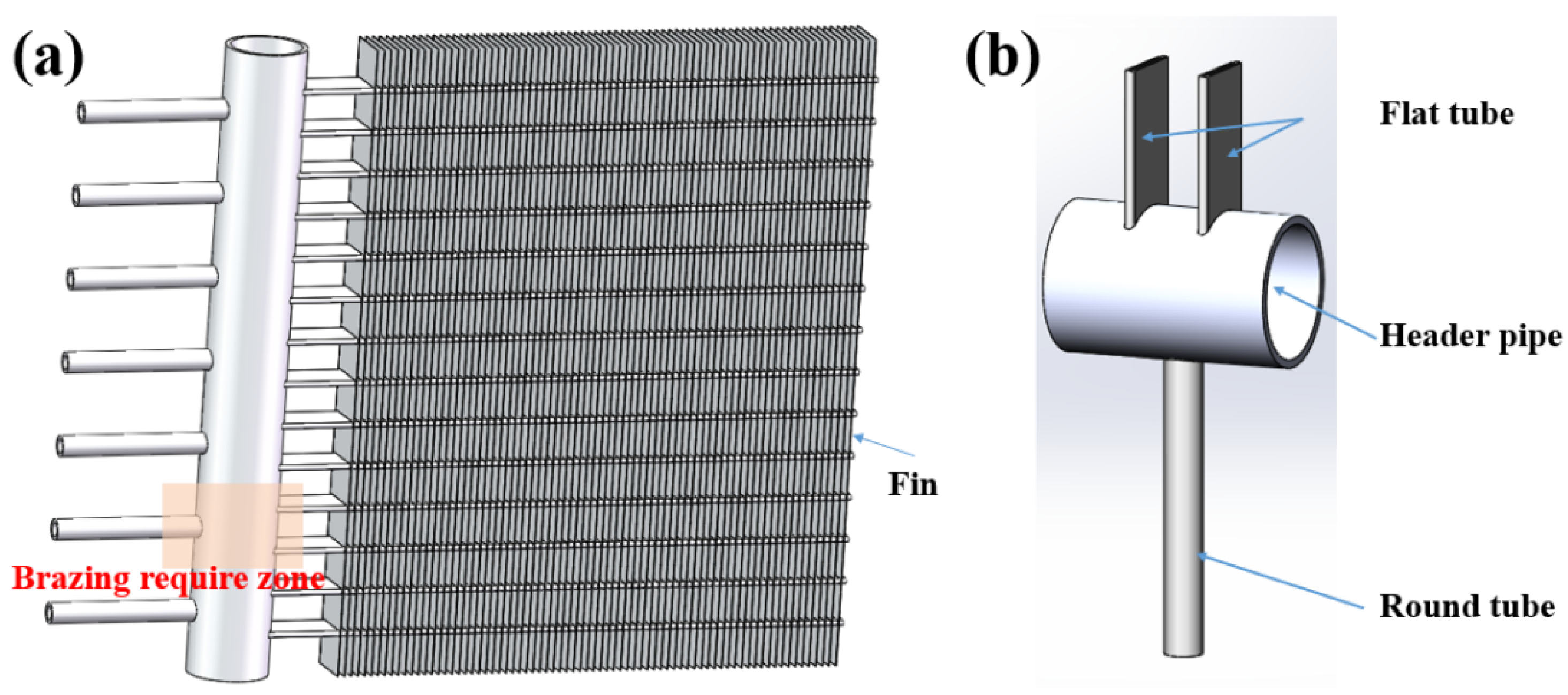


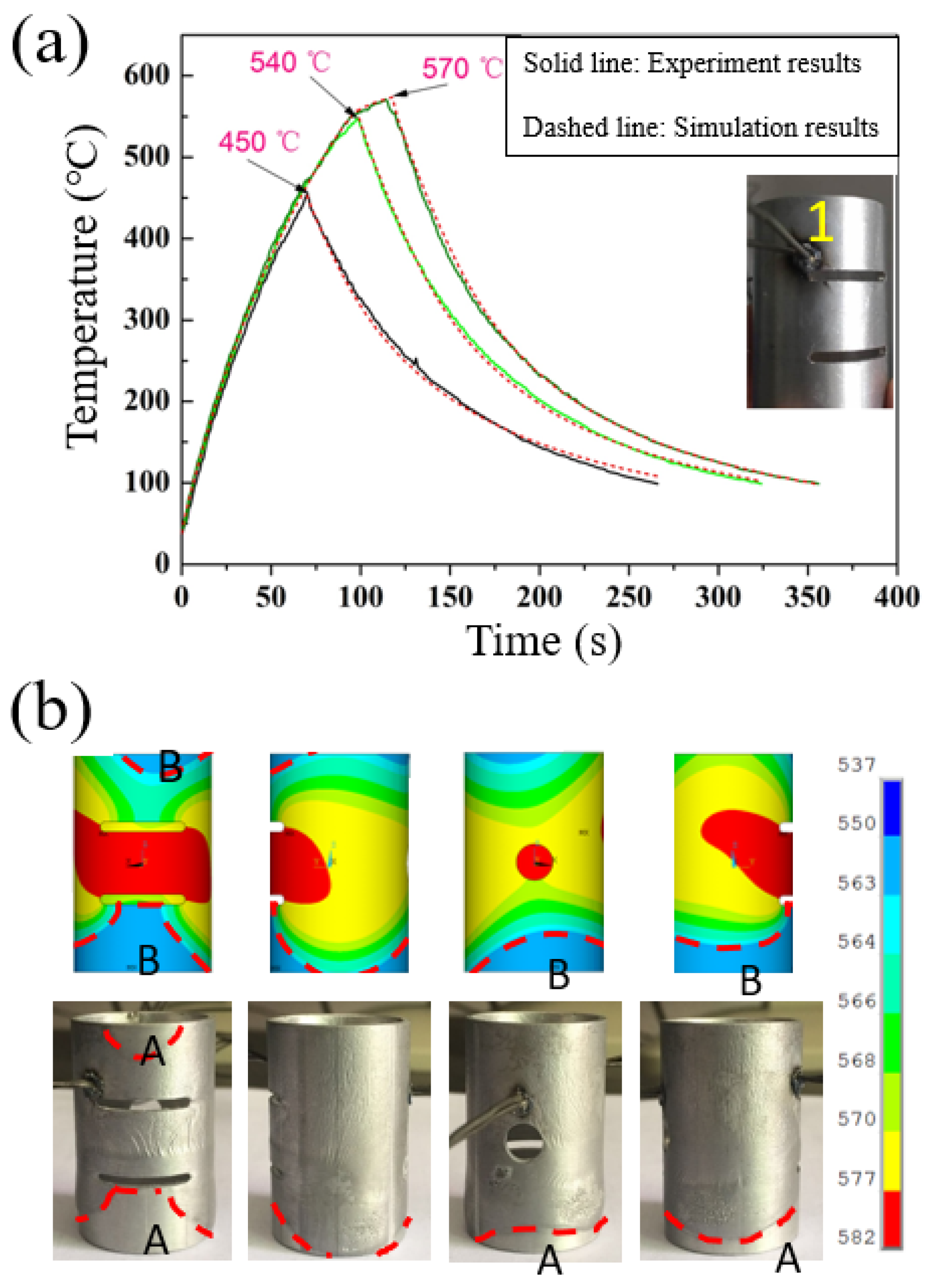
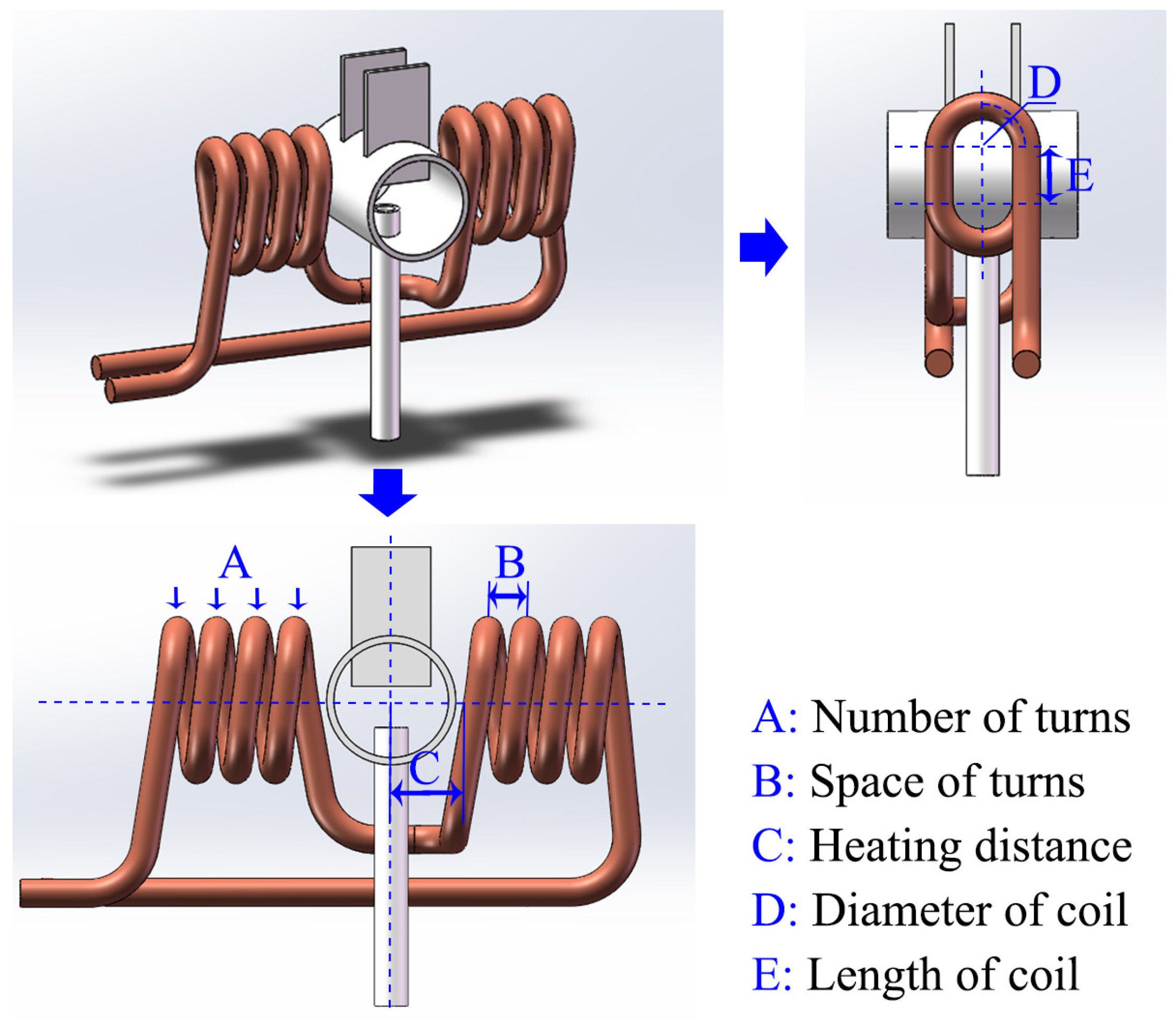

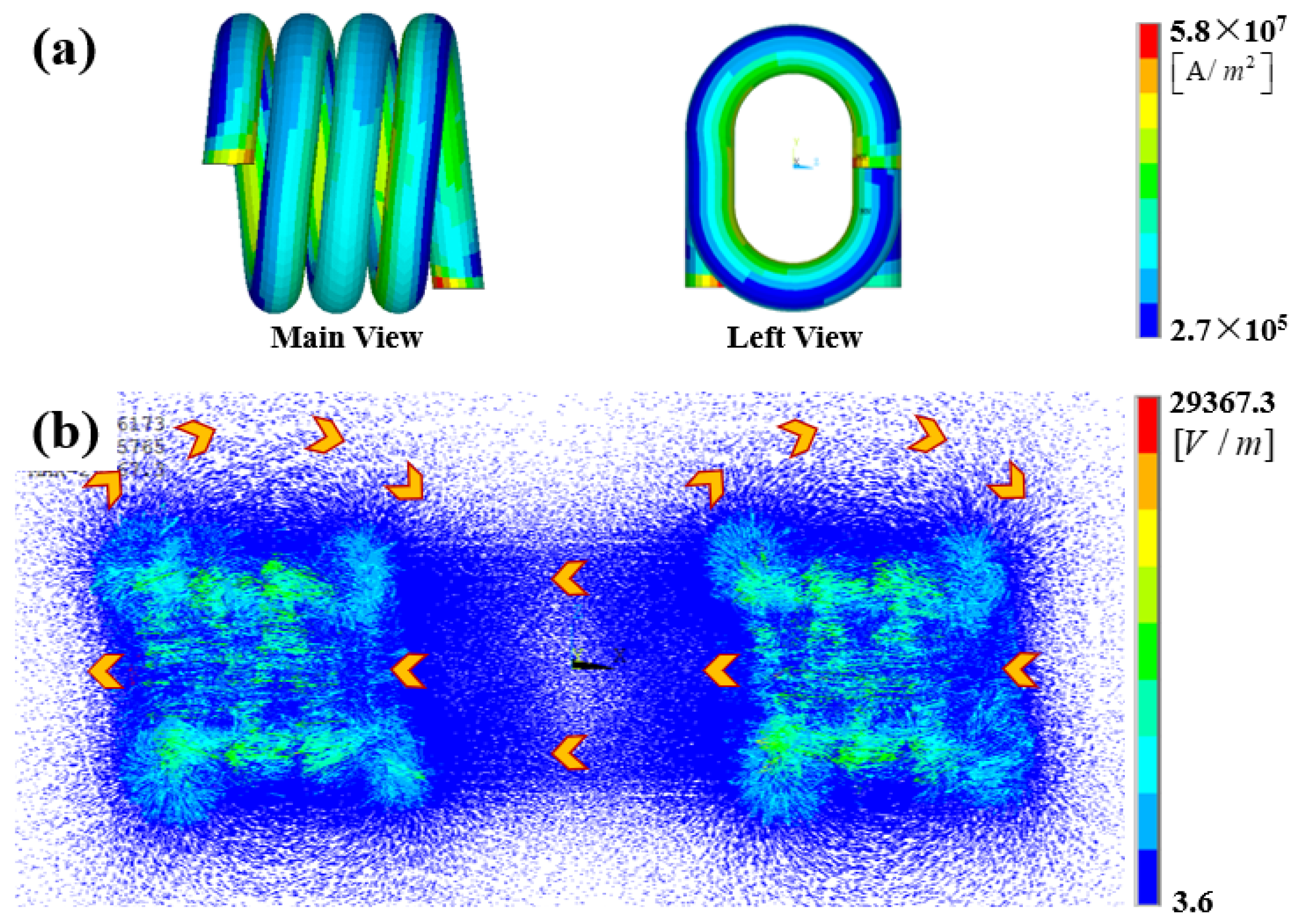
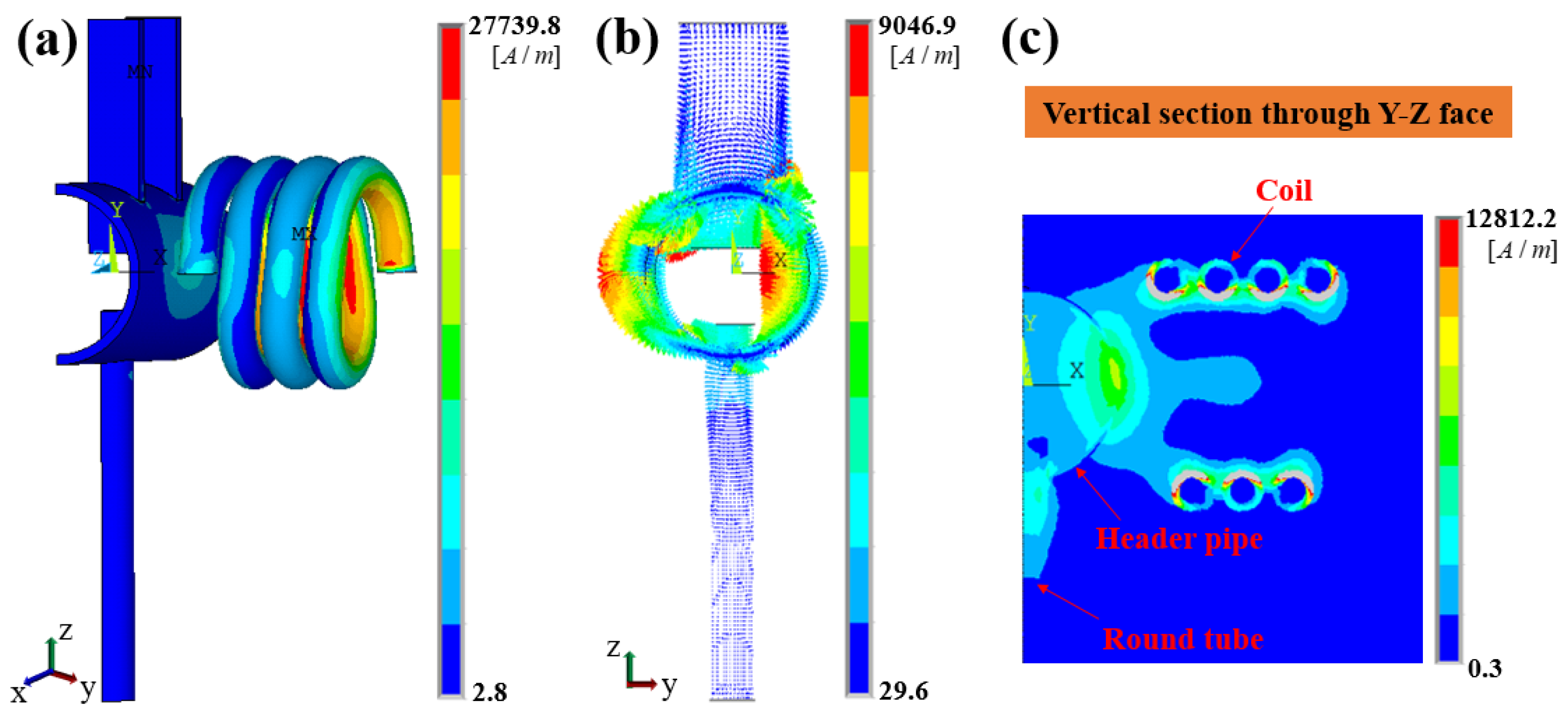
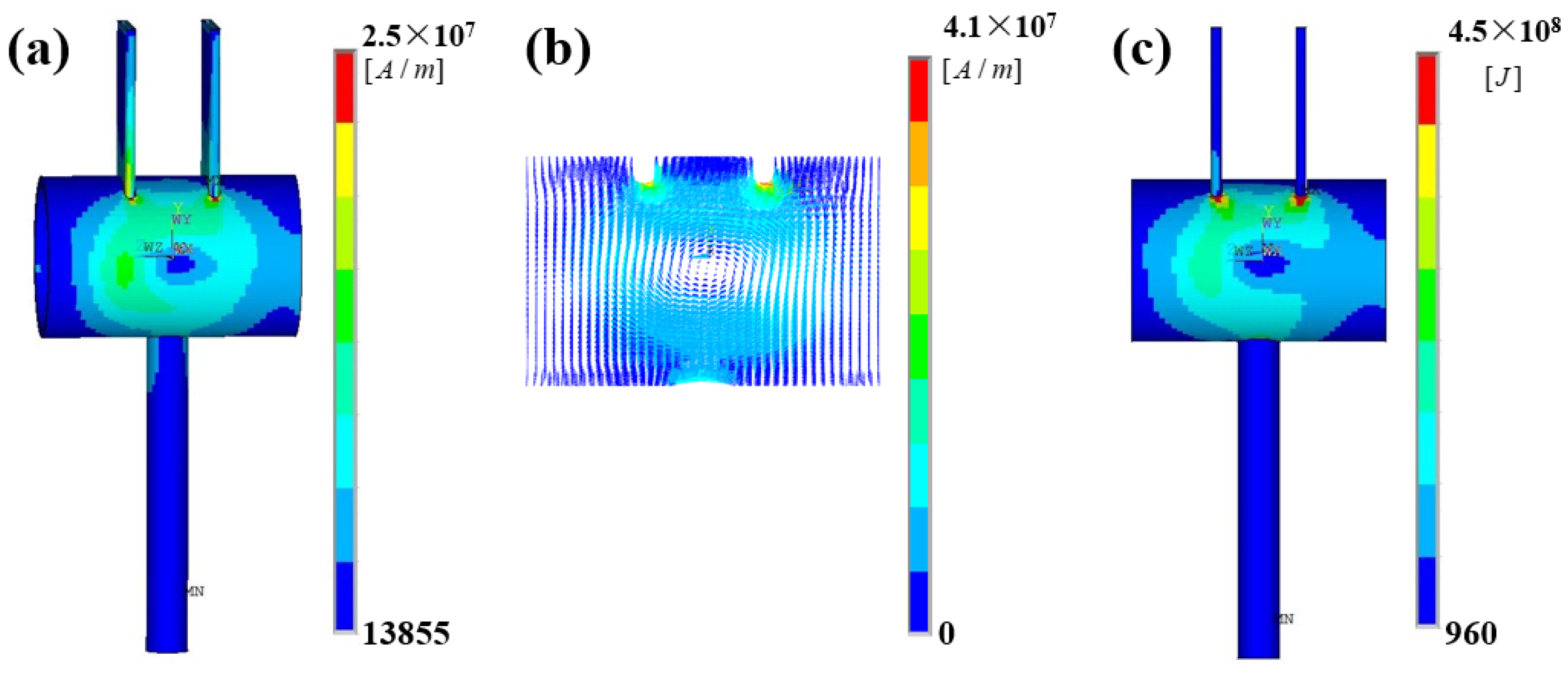
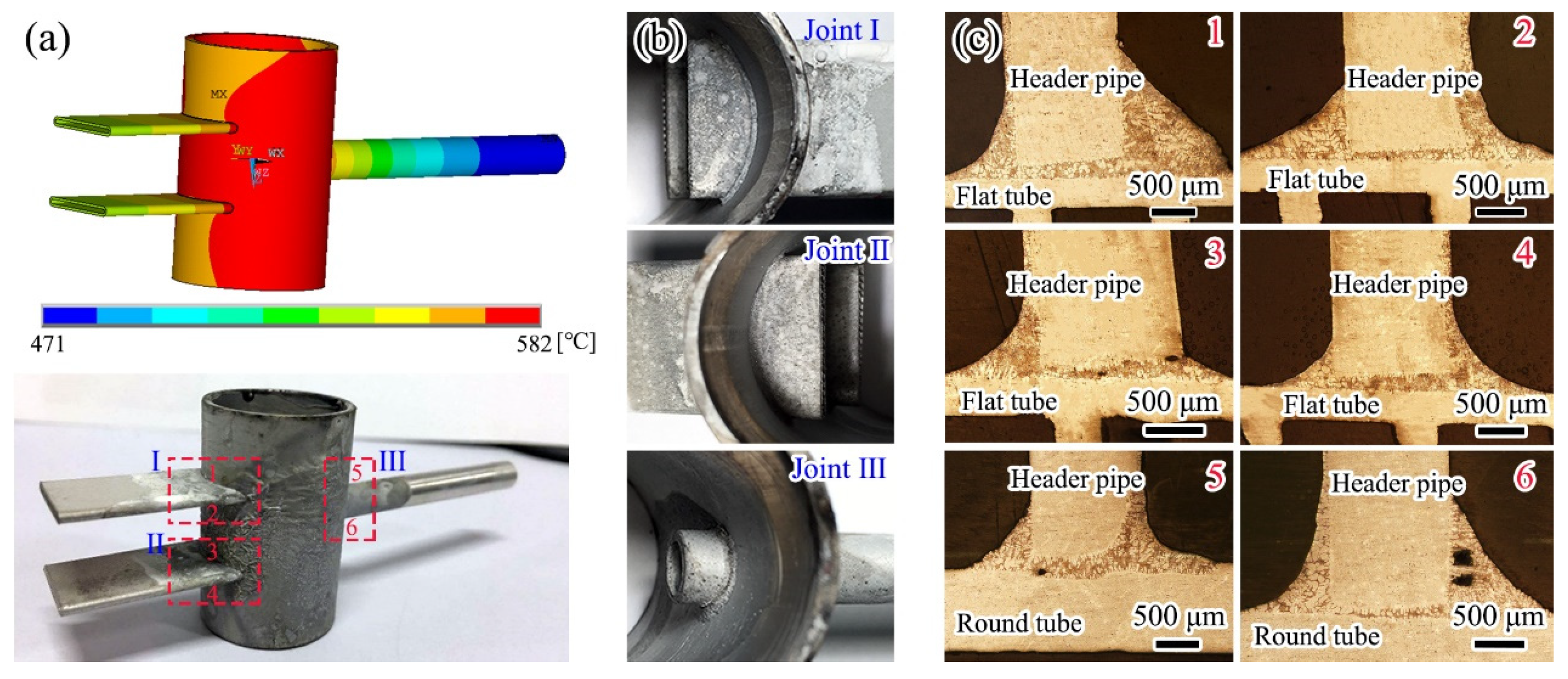
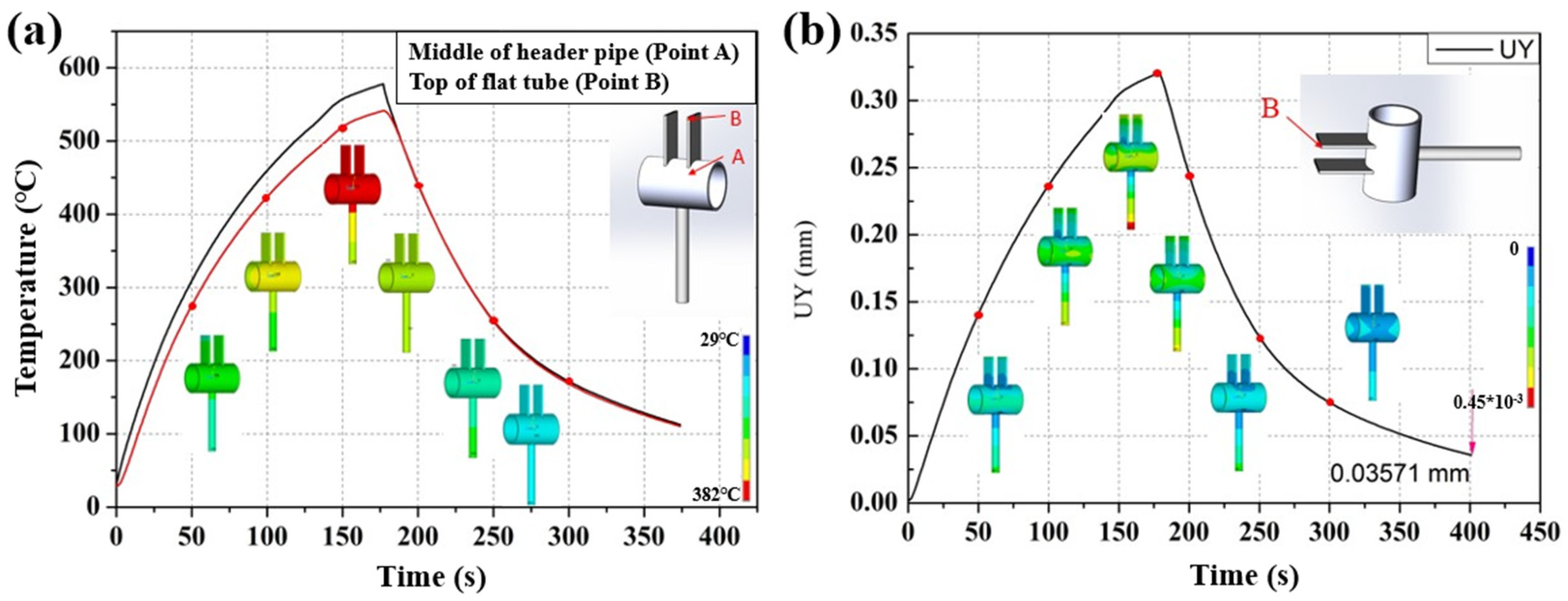
| Brand | Si | Fe | Cu | Mn | Mg | Zn | Ti | Al |
|---|---|---|---|---|---|---|---|---|
| A1050 | 0.25 | 0.40 | 0.05 | 0.05 | 0.05 | 0.05 | 0.03 | Bal. |
| A3003 | 0.6 | 0.7 | 0.05 | 1.0 | - | 0.1 | - | Bal. |
| A4045 | 10.0 | 0.8 | 0.3 | 0.05 | 0.05 | 0.10 | 0.2 | Bal. |
| Field | Electromagnetic Field | Temperature and Stress-Coupled Field | ||
|---|---|---|---|---|
| Element Type | Material Properties | Element Type | Material Properties | |
| Flat tube | Solid 97 | MURX, RSVX | Solid 5 | KXX, DENS, C, ALPX, EX, PRXY |
| Round tube | Solid 97 | MURX, RSVX | Solid 5 | KXX, DENS, C, ALPX, EX, PRXY |
| Header pipe | Solid 97 | MURX, RSVX | Solid 5 | KXX, DENS, C, ALPX, EX, PRXY |
| Gap | Solid 97 | MURX | Solid 5 | KXX, DENS, C, ALPX, EX, PRXY |
| Coil | Solid 97 | MURX, RSVX | Solid 5 | None |
| Air | Solid 97 | MURX | Solid 5 | None |
| Influential Factor | Unit | Factor Level | |||
|---|---|---|---|---|---|
| Level 1 | Level 2 | Level 3 | Level 4 | ||
| A. Number of turns | 2.5 | 3.5 | 4.5 | 5.5 | |
| B. Space of turn | mm | 6 | 7 | 8 | 9 |
| C. Heating distance | mm | 16.1 | 17.1 | 18.1 | 19.1 |
| D. Diameter of coil | mm | 4 | 6 | 8 | 10 |
| E. Length of coil | mm | 0 | 3 | 6 | 9 |
| Influential Factor | Unit | Symbol | Factor Level | |
|---|---|---|---|---|
| Level 1 | Level 2 | |||
| A. Lateral deviation | mm | 0 | ±0.5 | |
| B. Longitudinal deviation | mm | 0 | ±0.5 | |
| Orthogonal Table Type | Inner Orthogonal Array L16 (45) | External Orthogonal Array L4 (22) | |||||||||
|---|---|---|---|---|---|---|---|---|---|---|---|
| Factor | Control factor | Noise Factor | |||||||||
| Exp. order | Arrangement | ||||||||||
| S11 | S12 | S21 | S22 | ||||||||
| Column | A | B | C | D | E | 1 | 1 | 2 | 2 | U | |
| Exp. Order | 1 | 2 | 1 | 2 | V | ||||||
| 1 | 1 | 1 | 1 | 1 | 1 | y11 | y12 | y13 | y14 | ||
| 2 | 1 | 2 | 2 | 2 | 2 | y21 | y22 | y23 | y24 | ||
| 3 | 1 | 3 | 3 | 3 | 3 | y31 | y32 | y33 | y34 | ||
| 4 | 1 | 4 | 4 | 4 | 4 | y41 | y42 | y43 | y44 | ||
| 5 | 2 | 1 | 2 | 3 | 4 | y51 | y52 | y53 | y54 | ||
| 6 | 2 | 2 | 1 | 4 | 3 | y61 | y62 | y63 | y64 | ||
| 7 | 2 | 3 | 4 | 1 | 2 | y71 | y72 | y73 | y74 | ||
| 8 | 2 | 4 | 3 | 2 | 1 | y81 | y82 | y83 | y84 | ||
| 9 | 3 | 1 | 3 | 4 | 2 | y91 | y92 | y93 | y94 | ||
| 10 | 3 | 2 | 4 | 3 | 1 | y101 | y102 | y103 | y104 | ||
| 11 | 3 | 3 | 1 | 2 | 4 | y111 | y112 | y113 | y114 | ||
| 12 | 3 | 4 | 2 | 1 | 3 | y121 | y122 | y123 | y124 | ||
| 13 | 4 | 1 | 4 | 2 | 3 | y131 | y132 | y133 | y134 | ||
| 14 | 4 | 2 | 3 | 1 | 4 | y141 | y142 | y143 | y144 | ||
| 15 | 4 | 3 | 2 | 4 | 1 | y151 | y152 | y153 | y154 | ||
| 16 | 4 | 4 | 1 | 3 | 2 | y161 | y162 | y163 | y164 | ||
| Classification | Magnetic Field Intensity around the Joint and Distribution near the Flat Tube and Round Tube | Minimum Temperature on Header Pipe/°C | ||||||||
|---|---|---|---|---|---|---|---|---|---|---|
| Score | 1 | 2 | 3 | 4 | 1 | 2 | 3 | 4 | 5 | 6 |
| Content | High and uniform | Higher and more uniform | Higher and most uniform | Highest and most uniform | <573 | 573–580 | 580–585 | 585–590 | 590–595 | 595–600 |
Disclaimer/Publisher’s Note: The statements, opinions and data contained in all publications are solely those of the individual author(s) and contributor(s) and not of MDPI and/or the editor(s). MDPI and/or the editor(s) disclaim responsibility for any injury to people or property resulting from any ideas, methods, instructions or products referred to in the content. |
© 2023 by the authors. Licensee MDPI, Basel, Switzerland. This article is an open access article distributed under the terms and conditions of the Creative Commons Attribution (CC BY) license (https://creativecommons.org/licenses/by/4.0/).
Share and Cite
Zhang, Z.; Yang, Z.; Xie, P.; Zhao, Y.; Shan, J.; Liu, Y.; Wu, A.; Ma, S.; Zhang, L.; Chen, H. Key Parameters and Optimal Design of a Split Induction Coil for T-Shaped Pipe Brazing. Coatings 2023, 13, 940. https://doi.org/10.3390/coatings13050940
Zhang Z, Yang Z, Xie P, Zhao Y, Shan J, Liu Y, Wu A, Ma S, Zhang L, Chen H. Key Parameters and Optimal Design of a Split Induction Coil for T-Shaped Pipe Brazing. Coatings. 2023; 13(5):940. https://doi.org/10.3390/coatings13050940
Chicago/Turabian StyleZhang, Zhenlin, Ziheng Yang, Pu Xie, Yue Zhao, Jiguo Shan, Yan Liu, Aiping Wu, Sida Ma, Lei Zhang, and Hui Chen. 2023. "Key Parameters and Optimal Design of a Split Induction Coil for T-Shaped Pipe Brazing" Coatings 13, no. 5: 940. https://doi.org/10.3390/coatings13050940
APA StyleZhang, Z., Yang, Z., Xie, P., Zhao, Y., Shan, J., Liu, Y., Wu, A., Ma, S., Zhang, L., & Chen, H. (2023). Key Parameters and Optimal Design of a Split Induction Coil for T-Shaped Pipe Brazing. Coatings, 13(5), 940. https://doi.org/10.3390/coatings13050940








